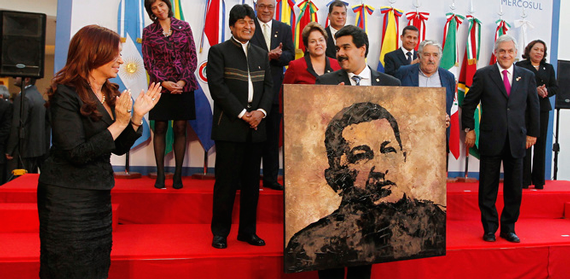The way we were. Reuters/Enrique Marcarian
Guest post by Neil Pyper
It suddenly feels as if the sun is setting on the bold leftism that bedded in across Latin America in the 2000s – and some of the region’s biggest players are drifting (or in some cases lurching) noticeably to the right.
Not so long ago, it seemed the 21st century would belong to the left. Left-wing governments were elected in Bolivia, Ecuador, Nicaragua and (briefly) Honduras; left-of-centre parties repeatedly won elections in Argentina and Brazil. Though the centre-right Sebastian Piñera did serve one presidential term, even former neoliberal poster child Chile was generally run by a centre-left government.
But now, two of the region’s big leftist beasts look set to radically change tack. The surprise election of Mauricio Macri as president of Argentina heralds the end of the boisterous big-government ways of “Kirchnerismo”, while Venezuela’s socialist project has finally been dealt a serious body blow at the ballot box.
And the course correction isn’t confined to the boldest left-wing states. More moderate left-of-centre governments have also run into trouble: see for example the corruption scandal relating to state-controlled oil company Petrobras that’s engulfing the centre-left Rousseff administration in Brazil. This has led to impeachment proceedings being initiated against the president herself.
The chaos on the left isn’t quite as sudden a downturn as it seems. While the administration of President Nicolás Maduro has undoubtedly been hurt by a slump in oil prices, Venezuela’s brand of socialism has simply proven untenable without Chávez’s energy and charisma. And even as Maduro has become increasingly authoritarian in his attitude to dissent, his government’s economic incompetence is now impossible to refute.
The Petrobras corruption scandal, meanwhile, has been rumbling for some time, and was making trouble even before a rash of huge demonstrations over high levels of spending on the 2016 Rio Olympics and 2014 World Cup.
But the shrivelling of the left has been going on for longer even than this. Take a closer look at the way these governments have acted since the 2000s and we can see that while their rhetoric has been sharply ideological, their policies have often been far more moderate.
Feeling their way
Dilma Rousseff’s Workers’ Party has been relatively pragmatic ever since wildly popular former President Luiz Inacio Lula da Silva was first elected in 2002. Its economic policies in particular have been relatively non-ideological, notably its enthusiastic embrace of large-scale agriculture.
Similarly, despite plently of fiery anti-capitalist and anti-US statements, Ecuador’s President Rafael Correa has proved more pragmatic than radical, again particularly on economic policy. This has even been the case in Bolivia, which is still governed by left-wing icon Evo Morales. While he made several high-profile nationalisations early in his term, especially in the oil and gas sectors, and has sought to increase the state’s role in the economy, Morales is also respecting private property and has proven to be relatively pragmatic, now pursuing a macroeconomic policy revolving around substantial foreign currency reserves.
Not feeling it. Reuters/David Mercado
Nicaragua’s president, Daniel Ortega was once a hero of the left as leader of the Nicaraguan revolution. But now he’s co-operated with Washington to combat drug trafficking and kept Nicaragua a committed member of the Central American Free Trade Agreement (DR-CAFTA) – which is designed to open up the region’s markets to the US.
In any case, the much-ballyhooed shift to the left was not really a uniform one in the first place. Peru, for instance, has seen a string of leaders shift noticeably to the right after being elected on centre-left platforms.
However, many of the right-of-centre governments actually pursued quite similar social policies to their counterparts on the left. Successive Peruvian governments reduced inequality substantially through increased welfare spending in the form of conditional cash transfers, payments to poor families in return for vaccinating children or sending them to school. This was also a banner policy of centre-right National Action Party (PAN) governments in Mexico from 2000-2012.
All of this has taken place against a backdrop of a remarkably long period of stable democratic government. Yes, concerns have been raised about the transparency and human rights records of some governments (Venezuela’s especially). Nonetheless, the international condemnation that followed the coup that removed Honduran President Manuel Zelayain 2009 was a reminder that violent interruptions to democratic rule are now exceptional. This is in sharp contrast to the 1970s, when most of the region was ruled by sometimes brutal unelected and military governments and polarisation between left and right was particularly marked.
How times change
So why is this happening, and why now? Certainly, economic management in most of Latin America during the global financial crisis was strikingly prudent and competent, largely because of painful memories of financial crises in the relatively recent past.
Similarly, past crises, mismanagement and high profile corruption mean that most of Latin America holds its politicians in exceptionally low regard. While some charismatic presidents may have periods of very high popularity, generally this does not extend to their ministers or to elected representatives in other branches of government.
Latin American citizens have a deep reserve of painful memories. Plenty of voters and politicians alike remember the repression and in many countries the downright incompetence that accompanied previous periods of intransigent undemocratic rule, and they have no wish to go back.
The mismatch between fiery rhetoric and pragmatic policy can no longer be ignored, while diehard holdouts can no longer sustain their projects. For all that it has been celebrated by some 21st century leftists as an anti-capitalist or socialist laboratory, Latin America may turn out to have been a region of pragmatic centrists all along.
Originally written for ‘the Conversation’.





Comments are disabled